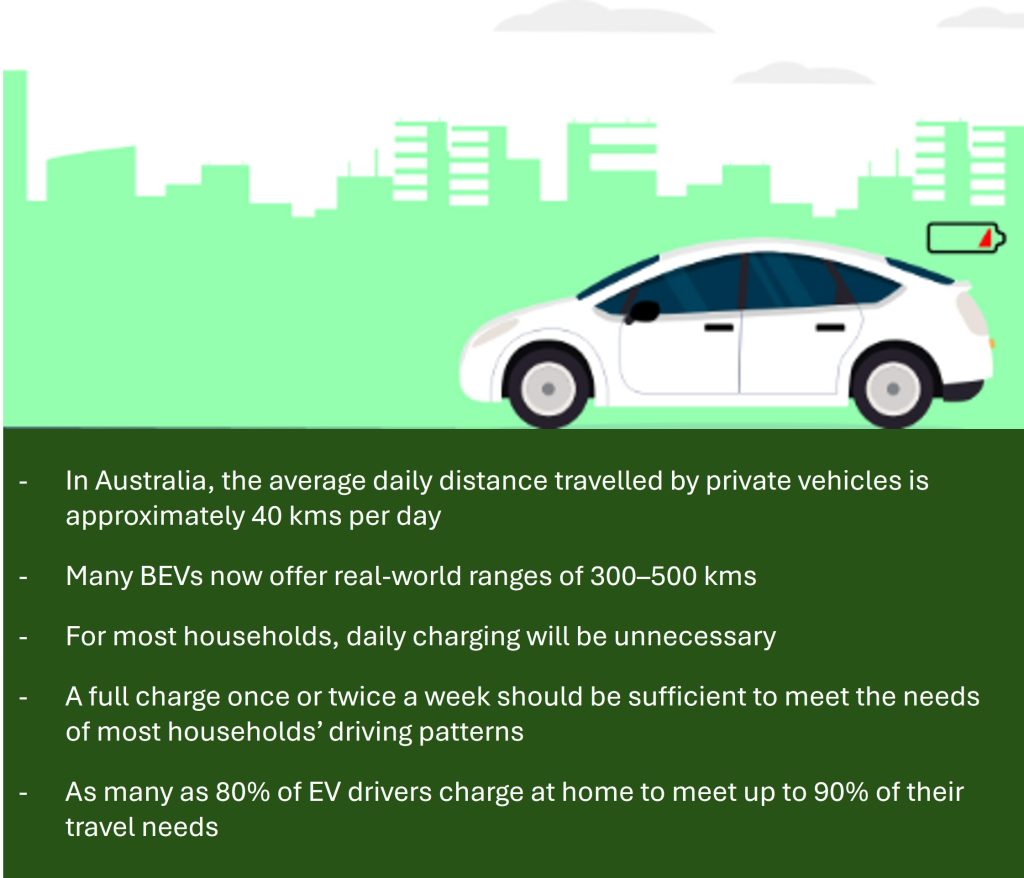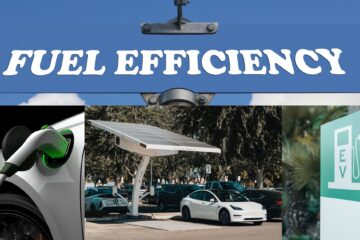Understanding Actual Travel Needs
In Australia, the average daily distance travelled by private vehicles is approximately 40 kms per day, well within the range of every BEV on the market today. Many BEVs now offer real-world ranges of 300–500 kms. For most households, daily charging will be unnecessary. A full charge once or twice a week should be sufficient to meet the needs of most households’ driving patterns.

Home Charging as the Primary Solution
A significant advantage of BEVs is the ability to charge conveniently at home, particularly overnight when electricity demand and prices are lower. Data shows that as many as 80% of EV drivers charge at home to meet up to 90% of their travel needs.
- Installing home chargers (Level 1 and 2 chargers) allows users to start each day with a full battery, effectively eliminating most concerns about running out of charge.
- This is particularly relevant for suburban and regional settings where off-street parking is available.
Home charging not only reduces reliance on public charging infrastructure, but also offers potential for integration with rooftop solar systems, further enhancing cost savings and environmental benefits.
Workplace Charging
Employers, particularly those transitioning their fleet to EVs, can significantly reduce range anxiety for employees by:
- Installing workplace charging stations (either AC or DC fast chargers) to ensure fleet vehicles can be charged during working hours or overnight for shift-based operations.
- Establishing policies to enable overnight charging for fleet vehicles, particularly for roles involving high daily mileage or remote travel.
Workplace charging plays a critical supporting role for employees charging at home, eliminating the need for public charging. Providing EV charging for employees’ private vehicles could be the incentive many employees need to encourage them to return to work.
Such steps are already being implemented by progressive councils seeking to reduce emissions, meet sustainability targets, and lower operating costs through BEV adoption.
Public Charging as a Complement
While the expansion of public fast-charging networks remains essential for long-distance travel and equitable access for those without off-street parking, it is important to emphasise that:
- With home charging and workplace charging, most EV users will rarely need to rely on public charging.
- Public fast chargers provide confidence for longer journeys, but daily commutes should be well within home/work charging capabilities.
This is like the way drivers refuel petrol vehicles – most of the time, journeys are local and extended trips are the exception.
Changing Perceptions Through Experience
Range anxiety is often disproportionate to actual risk and travel trends. Research and surveys of new EV owners consistently show that initial concerns about range fade once users become familiar with their vehicle’s capabilities and real-world usage.
To support this cultural shift:
- Organisations and governments can facilitate EV education and trials, allowing users to experience BEVs without commitment.
- Councils can lead by example through fleet electrification, visibly demonstrating the feasibility of EV use in practical service delivery contexts.
Conclusion
The combination of home charging, workplace charging, and improved public infrastructure, alongside the reality that average daily travel distances are modest, provides a strong foundation to overcome range anxiety. Most Australian drivers—whether in urban or regional settings—can transition to BEVs without significant disruption to their current patterns of use.
There may be an argument for councils in some regional and remote settings to transition some of their high-utilisation operational vehicles to PHEVs.
This message needs to be consistently communicated to counteract outdated perceptions, particularly as the vehicle market, infrastructure, and policy environment continue to mature in support of transport decarbonisation.



0 Comments